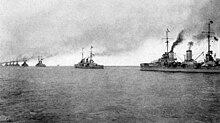Keel line (formation)

Ships travel in the keel line when they are exactly one behind the other, so that the following ship is always in the wake of the one ahead.
The formation of the keel line was important as a tactical formation, as the ships involved could all fire a broadside at the same time .
In the days of the ships of the line , one possible tactic was to break through the opposing keel line, so that your own guns (each fired individually when the enemy passed) could strike the enemy ships lengthways, causing devastating damage to the gun decks and the rigging that were not divided by transverse bulkheads let. This tactic became particularly well known from the Battle of Trafalgar .
The keel line became meaningless with the development of armored warships, the main armament of which was set up in rotating towers. Now one tried specifically to maneuver one's own keel line in front of that of the opponent in order to gain a combat advantage. This tactic is known as crossing the t known.
Today, however, the keel line is only important as a representative formation. In contrast to the keel line is the formation of the Dwars line , where the ships are next to each other.
literature
- Nicolas Marie Ozanne: Marine militaire, ou Recueil des differens vaisseaux qui servent à la guerre, suivis des manoeuvres qui ont le plus de raport au combat, ainsi qua l'ataque et la deffense des ports. Paris 1762 Textbook for prospective naval officers with graphic representations.
- Duden , accessed on December 23, 2012.
